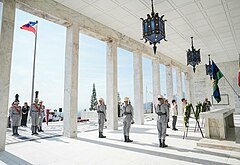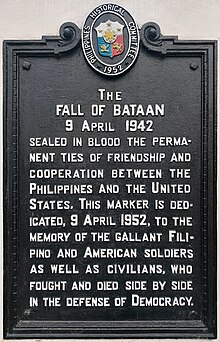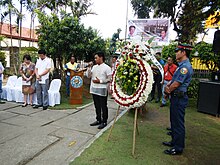| Day of Valor | |
|---|---|
 Philippine President Bongbong Marcos offering wreath at Mount Samat National Shrine in Pilar, Bataan, on Day of Valor 2024 | |
| Official name | Araw ng Kagitingan |
| Also called |
|
| Observed by | Philippines (nationwide), United States (Maywood, Illinois) |
| Significance | Commemorates the fall of Bataan during World War II |
| Date | April 9 |
| Next time | April 9, 2025 |
| Frequency | Annual |
| First time | April 9, 1961 (as Philippine holiday) |
The Day of Valor, officially known as Araw ng Kagitingan, is a national observance in the Philippines that commemorates the fall of Bataan to Japanese troops during World War II. The day is officially celebrated every April 9, the start of the Bataan Death March, although the date was moved on several occasions to avoid it from coinciding with the observance of the Holy Week in the country, especially the Easter Triduum and Easter Sunday, such as in 2004, 2009, 2020, and 2023.[1][2][3]
Due to Bataan's significance in World War II, the holiday was officially known as Bataan Day or Corregidor Day prior to the 2000s and is still known under this name by others. In the United States, the holiday is celebrated in Maywood, Illinois, where it is referred to by its old name.
Background
[edit]
At dawn on April 9, 1942, against the orders of Generals Douglas MacArthur and Jonathan Wainwright, the commander of the Luzon Force, Bataan, Major General Edward P. King, Jr., surrendered more than 76,000 starving and disease-ridden soldiers (64,000 Filipinos and 12,000 Americans) to Japanese troops.[4]
The majority of these prisoners of war had their belongings confiscated before being forced to endure the infamous 140-kilometer (87 mi) Bataan Death March to Camp O'Donnell in Capas, Tarlac. En route, thousands died from dehydration, heat prostration, untreated wounds, and wanton execution while walking in deep dust over vehicle-broken Macadam roads, and crammed into rail cars for transport to captivity.[5]
The few who were lucky enough to travel by truck to San Fernando, Pampanga would still have to endure more than 25 miles (40 km) of additional marching. Prisoners were beaten randomly and often denied promised food and water. Those who fell behind were usually executed or left to die, with the sides of the roads becoming littered with dead bodies and those moaning for help.[6]
Only 54,000 of the 76,000 prisoners (66,000 Filipinos and 10,000 Americans) reached their destination;[7] the exact death toll is difficult to assess because thousands of captives were able to escape from their guards. Approximately 3,000 prisoners may have died during the march, and 25–30,000 more while in captivity.[7][8]
History
[edit]Philippines
[edit]In April 1961, Philippine President Carlos P. Garcia signed Republic Act No. 3022 into law, declaring April 9 of every year as "Bataan Day".[9]
In June 1987, Executive Order No. 203 revised all national holidays in the Philippines, referring to the April 9 holiday as "Araw ng Kagitingan (Bataan and Corregidor Day)".[10] Less than a month later, another executive order (No. 292) revised the holidays anew, again referring to the April 9 holiday as "Araw ng Kagitingan (Bataan and Corregidor Day)".[11]
In 2007, Congress passed Republic Act No. 9492, putting into law the "Holiday Economics" policy of President Gloria Macapagal Arroyo; this put the observance of each holiday, with the exception of New Year's Day and Christmas, to the Monday nearest it. The order referred to the holiday celebrated on the Monday nearest April 9 as "Araw ng Kagitingan (Bataan and Corregidor Day)".[12] Starting in 2008, the holiday was called simply as "Araw ng Kagitingan", and was celebrated on the nearest Monday.[13] This practice was repeated in 2009.[14] In 2010, the holiday was still named as such, but was celebrated on April 9.[15]
Starting with the administration of President Benigno Aquino III, celebrations of the holiday have been observed on April 9, instead of being moved to the nearest Monday, and the holiday has been called simply "Araw ng Kagitingan" since 2011.[16][17][18][19][20][21][22][23][24][25][26][27]
However, during the term of President Bongbong Marcos, April 10, 2023 was declared a special non-working holiday instead of April 9, by virtue of Proclamation No. 90.[28] The holiday was included in the "holiday economics", adjusting the observance of the holiday to the nearest Monday for a longer weekend, while Easter Sunday would fall on April 9, 2023.[29]
United States
[edit]The United States Congress passed a joint resolution on April 8, 1954, declaring the next day, April 9, 1954, the 12th anniversary of the fall of Bataan, as "Bataan Day." The joint resolution also mentioned that Philippine President Ramon Magsaysay had earlier declared it to be such.[30]
On April 8, 1987, U.S. President Ronald Reagan, by virtue of Senate Joint Resolution 47 declared April 9, 1987, as "National Former POW Recognition Day".[31] President Joe Biden continued the tradition, declaring April 9, 2021, as such.[32]
Observance
[edit]Philippines
[edit]
The observance usually is centered on Mount Samat National Shrine in Pilar, Bataan. It is usually attended by the President of the Philippines, the Governor of Bataan, the ambassadors of the United States and Japan, and surviving veterans groups.
By 2021, there were only 2,952 defenders of Bataan who are still alive.[33]
2012
[edit]In 2012, the 70th anniversary of the Fall of Bataan was commemorated at Mount Samat Shrine in Pilar, Bataan by some of the over 18,000 still-living Filipino veterans.
Then-incumbent President Benigno S. Aquino III and former President Fidel V. Ramos attended the rites. Japanese ambassador to the Philippines Toshina Urabe expressed "deep apology and a deep sense of remorse to the tragedy", while the United States Deputy Chief of Mission Leslie A. Bassett (representing U.S. ambassador Harry K. Thomas Jr.) said that their embassy has provided a total of US$220 million (over ₱9 billion) to Filipino war veterans.[34]
United States
[edit]In Maywood, Illinois, the second Sunday in September is remembered as Bataan Day.[35][36] Maywood provided Illinois National Guard soldiers of the 192nd Tank Battalion who served on Bataan.
In Honolulu, Hawaii there is an annual commemoration at the National Cemetery of the Pacific.[citation needed]
References
[edit]- ^ Proclamation No. 295: Declaring 2012 National Holidays Archived February 13, 2023, at the Wayback Machine, December 12, 2011, Official Gazette of the Philippines
- ^ "DOLE reminds employers on pay guidelines for Holy Week holidays". GMA News and Public Affairs. April 4, 2009.
- ^ Damicog, Jeffrey (April 10, 2023). "'Araw ng Kagitingan' should continuously inspire Filipinos – Sec Remulla". Manila Bulletin. Retrieved April 10, 2023.
- ^ Tucker, Spencer C.; Roberts, Priscilla Mary (2005). World War II: A Student Encyclopedia [5 volumes]. ABC-CLIO. pp. 180–181. ISBN 978-1-85109-858-3. Retrieved February 17, 2021.
- ^ Lansford, Tom (2001). "Bataan Death March". In Sandler, Stanley (ed.). World War II in the Pacific: an encyclopedia. Taylor & Francis. pp. 159–60. ISBN 978-0-8153-1883-5.
- ^ Greenberger, Robert (2009). The Bataan Death March: World War II Prisoners in the Pacific. Compass Point Books. p. 96. ISBN 978-0-7565-4095-1.
- ^ a b "Bataan Death March". britannica.com. Retrieved February 18, 2022.
- ^ "Bataan Death March". Interaksyon. April 8, 2012. Archived from the original on December 20, 2016. Retrieved December 5, 2016.
- ^ Republic Act No. 3022 (April 6, 1961), An Act Proclaiming the Ninth Day of April as Bataan Day and Declaring It as a Legal Holiday, Chan Robles Law Library
- ^ Executive Order No. 203 (June 30, 1987), Providing a List of Regular Holidays and Special Days to Be Observed Throughout the Philippines and for Other Purposes (PDF), Chan Robles Publishing Company
- ^ Executive Order No. 292 (July 25, 1987), Instituting the "Administrative Code of 1987", Official Gazette (Book I, Chapter 7 -- Regular Holidays and Nationwide Special Days)
- ^ Republic Act No. 9492 (July 24, 2007), "An Act Rationalizing the Celebration of National Holidays Amending for the Purpose Section 26, Chapter 7, Book 1 of Executive Order No. 292, as Amended, Otherwise Known as the Administrative Code of 1987", Official Gazette Library, archived from the original on February 18, 2023, retrieved May 22, 2020
- ^ "Proclamation No. 1463, s. 2008 | GOVPH". Official Gazette of the Republic of the Philippines. Retrieved April 9, 2021.
- ^ "Proclamation No. 1699, s. 2008 | GOVPH". Official Gazette of the Republic of the Philippines. Retrieved April 9, 2021.
- ^ "Proclamation No. 1841, s. 2009 | GOVPH". Official Gazette of the Republic of the Philippines. Retrieved April 9, 2021.
- ^ "PROCLAMATION NO. 84 : DECLARING THE REGULAR HOLIDAYS, SPECIAL (NON-WORKING) DAYS, AND SPECIAL HOLIDAY (FOR ALL SCHOOLS) FOR THE YEAR 2012" (PDF). Official Gazette of the Office of the President of the Philippines. December 2010. Archived from the original on October 20, 2013.
- ^ "PROCLAMATION NO. 295 : DECLARING THE REGULAR HOLIDAYS, SPECIAL (NON-WORKING) DAYS, AND SPECIAL HOLIDAY (FOR ALL SCHOOLS) FOR THE YEAR 2012". Official Gazette of the Office of the President of the Philippines. November 24, 2011. Archived from the original on February 13, 2023. Retrieved May 22, 2020.
- ^ "PROCLAMATION NO. 459 : DECLARING THE REGULAR HOLIDAYS, SPECIAL (NON-WORKING) DAYS, AND SPECIAL HOLIDAY (FOR ALL SCHOOLS) FOR THE YEAR 2013" (PDF). Official Gazette of the Office of the President of the Philippines. August 14, 2012.
- ^ "DECLARING THE REGULAR HOLIDAYS, SPECIAL (NON-WORKING) DAYS, AND SPECIAL HOLIDAY (FOR ALL SCHOOLS) FOR THE YEAR 2014". Official Gazette of the Office of the President of the Philippines. September 25, 2013.
- ^ "DECLARING THE REGULAR HOLIDAYS, SPECIAL (NON-WORKING) DAYS, AND SPECIAL HOLIDAY (FOR ALL SCHOOLS) FOR THE YEAR 2015". Official Gazette of the Office of the President of the Philippines. July 17, 2014.
- ^ "DECLARING THE REGULAR HOLIDAYS, SPECIAL (NON-WORKING) DAYS, AND SPECIAL HOLIDAY (FOR ALL SCHOOLS) FOR THE YEAR 2016". Official Gazette of the Office of the President of the Philippines. August 20, 2015. Archived from the original on June 23, 2017. Retrieved May 22, 2020.
- ^ "Proclamation No. 50, s. 2016 | GOVPH". Official Gazette of the Republic of the Philippines. Retrieved April 8, 2021.
- ^ "Proclamation No. 269" (PDF). July 17, 2017. Archived (PDF) from the original on August 8, 2017.
- ^ "Proclamation No. 555" (PDF). Archived (PDF) from the original on September 20, 2018.
- ^ "Proclamation No. 845" (PDF). November 15, 2019. Archived (PDF) from the original on November 2, 2020.
- ^ "Proclamation No. 986" (PDF). July 30, 2020. Archived (PDF) from the original on October 28, 2020.
- ^ "Proclamation No. 1236" (PDF).
- ^ Presidential Proclamation No. 90, s. 2022 (November 16, 2022), Amending Proclamation No. 42, S. 2022, declaring the regular holidays and special (non-working) days for the year 2023, retrieved January 1, 2023
- ^ Parrocha, Azer (November 16, 2022). "Palace updates list of holidays for 2023 with more long weekends". Philippine News Agency. Retrieved January 1, 2023.
- ^ "Text of S.J.Res. 143 (83rd): Joint resolution providing for the observance of April 9, the twelfth anniversary of … (Passed Congress version)". GovTrack.us. Retrieved January 30, 2022.
- ^ "Proclamation 5626—National Former POW Recognition Day, 1987 | The American Presidency Project". www.presidency.ucsb.edu. Retrieved February 1, 2022.
- ^ "A Proclamation on National Former Prisoner of War Recognition Day, 2021". The White House. April 9, 2021. Retrieved February 1, 2022.
- ^ "Day of Valor: World War II veterans battling virus pandemic". Manila Standard. Retrieved April 9, 2021.
- ^ Orejas, Greg Refraccion, Tonette (April 10, 2012). "Aquino assures war veterans of better health services; vows AFP modernization". INQUIRER.net. Retrieved April 9, 2021.
{{cite web}}: CS1 maint: multiple names: authors list (link) - ^ "70th Maywood Bataan Day". Maywood Bataan Day Organization. Archived from the original on March 5, 2016. Retrieved April 9, 2013.
- ^ p. 117 Bodnar, John The "Good War" in American Memory JHU Press, December 1, 2010